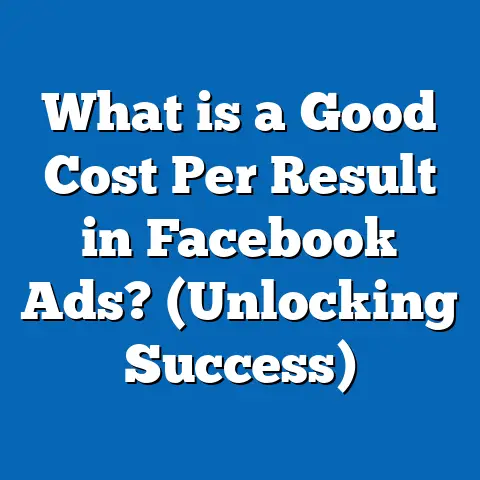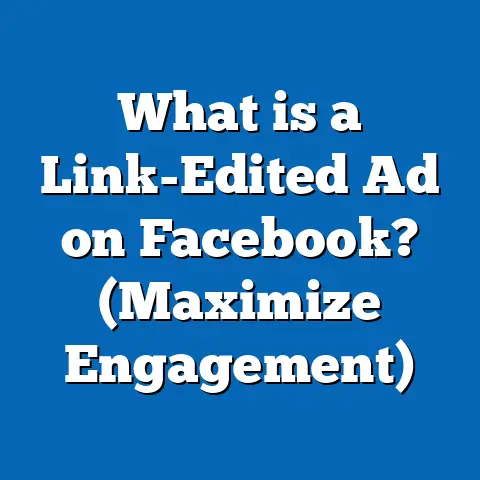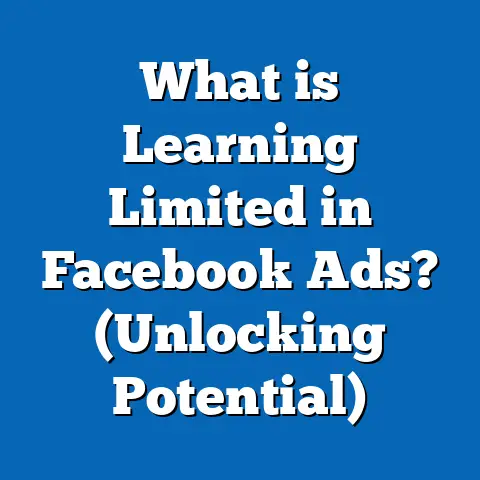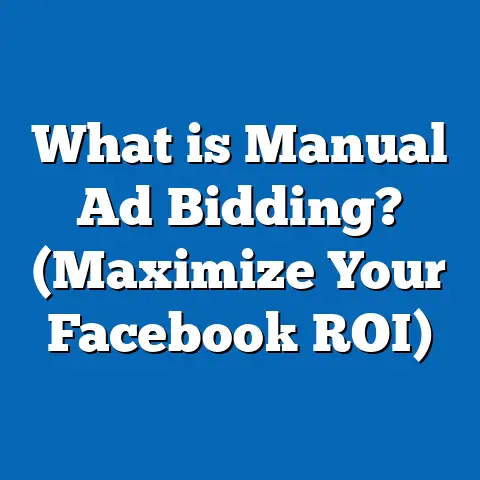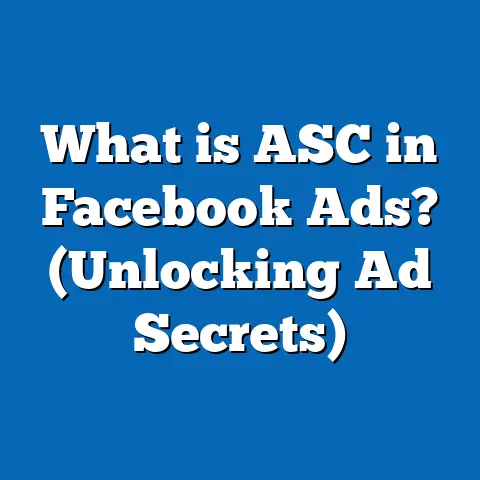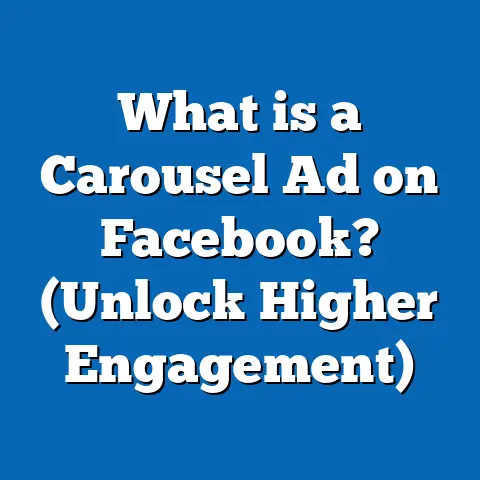What is Good Reach in Facebook Ads? (Understanding Metrics)
What is Good Reach in Facebook Ads? (Understanding Metrics)
Introduction: A Quick Win to Boost Your Facebook Ads Performance
Imagine you launch a Facebook ad campaign targeting 10,000 people. By the end, 9,000 people saw your ad, but only 100 clicked or engaged. Now, consider another campaign that reached just 5,000 people but generated 1,000 clicks and high engagement. Which campaign was more successful? The answer lies beyond just surface-level numbers like impressions or total spend. It’s about how effectively your ad reaches the right audience — this is where understanding reach becomes critical.
Reach is one of the most important metrics in Facebook advertising because it tells you how many unique individuals have seen your ad. But what counts as good reach, and how can you optimize your campaigns to hit or surpass those standards? This guide breaks down everything from basic concepts to advanced strategies and data-backed insights to help marketers and business owners master reach on Facebook.
Understanding Reach in Facebook Ads
What is Reach?
In the simplest terms, reach is the number of unique users who see your ad at least once. It counts people, not views.
- Reach differs from impressions, which counts every time your ad is shown — even if the same person sees it multiple times.
- For example, if your ad gets 1,000 impressions but only 500 unique people saw it, your reach is 500.
Facebook focuses on reach because it measures how broadly your message spreads across distinct individuals. It answers the question: How many different people saw my ad?
Why Does Reach Matter?
Reach is important for several reasons:
- Brand Awareness: A wide reach means more people know about your brand or offer.
- Audience Size: Helps you understand if your targeting is too narrow or broad.
- Campaign Effectiveness: Indicates whether your budget and ads are delivering to a meaningful number of users.
- Frequency Control: Helps balance how often people see your ads without causing fatigue.
Reach is a key driver of many campaign objectives, especially those focused on awareness and consideration stages in the marketing funnel.
Types of Reach on Facebook
Facebook categorizes reach into three types:
- Organic Reach: Number of people who see your content without paid promotion.
- Paid Reach: Number of people who see your ads due to paid placement.
- Viral Reach: Number of people who see your content because someone in their social network interacted with it (shares, likes).
For advertisers, paid reach is the primary focus since it directly relates to ad performance and budget spend.
What Constitutes Good Reach?
Context Is Key
There is no universally “good” or “bad” reach number because it depends on many variables:
- Campaign Goals: Are you focusing on brand awareness, lead generation, conversions, or sales?
- Target Audience Size: Larger audiences naturally allow for higher reach numbers.
- Budget: More budget usually equals higher potential reach.
- Industry and Market: Different niches have different average engagement and reach rates.
- Ad Placement & Creative Quality: Better ads tend to get more reach at lower cost.
Good reach means reaching an optimal portion of your intended audience at an efficient cost without causing ad fatigue.
Industry Benchmarks and Data on Reach
Several studies provide benchmarks to help understand good reach:
- According to AdEspresso (2023), average Facebook ad reach rates tend to be between 30% to 60% of the target audience over a typical campaign period.
- WordStream data shows that local businesses can expect a reach rate of around 40%+ of their target audience when running a well-optimized campaign.
- Larger brand awareness campaigns aim for millions of users reached but accept lower frequency per user.
The key is balancing reach with frequency — how many times each user sees the ad. High reach with very low frequency may not yield results since users don’t get enough exposure to act.
Frequency and Reach: The Balancing Act
Frequency tells you how often each user sees your ad on average. The goal is often to achieve an optimal frequency that maximizes impact without annoying users.
- Ideal frequency range: Around 1.5 to 3 times per user.
- If frequency is too low (<1), most people won’t see the ad enough to respond.
- If frequency is too high (>5), users may experience ad fatigue, leading to decreased engagement and higher costs.
Marketers should watch frequency alongside reach to ensure they are reaching enough unique users with effective repetition.
How to Measure and Analyze Reach Effectively
Tools for Tracking Reach on Facebook
Facebook Ads Manager provides detailed insights for every campaign including:
- Reach: Unique users who saw an ad at least once.
- Impressions: Total times the ad was displayed.
- Frequency: Average number of times each user saw the ad.
- Engagement Metrics: Clicks, likes, shares relative to reach.
- Relevance Score: Historical metric showing how relevant your ad is (now replaced by Quality Ranking).
Regularly monitoring these metrics helps advertisers tweak targeting, creatives, placements, and budget allocation.
Calculating Reach Rate
Reach rate helps contextualize raw reach numbers by comparing them against the total size of your target audience: Reach Rate (%)=(ReachTotal Target Audience Size)×100\text{Reach Rate (\%)} = \left(\frac{\text{Reach}}{\text{Total Target Audience Size}}\right) \times 100
For example:
- If your target audience size is 100,000 people
- And your ad reached 30,000 unique users
- Your reach rate = 30,000100,000×100=30%\frac{30,000}{100,000} \times 100 = 30\%
This tells you what percentage of your intended market you successfully exposed your message to.
Interpreting Reach Alongside Other Metrics
Reach alone doesn’t tell the full story. Combine it with:
- CTR (Click-through Rate): How many reached users clicked?
- Engagement Rate: Likes, comments, shares relative to reach
- Conversion Rate: How many reached users took desired actions?
A campaign with high reach but low engagement might need better creative or targeting adjustments.
Factors Influencing Reach in Facebook Ads
Understanding what impacts reach helps marketers optimize campaigns effectively.
Audience Targeting Precision
Narrow targeting reduces potential audience size but can increase relevance and engagement. Broad targeting increases potential reach but may reduce overall relevance.
For example:
- Targeting “Fitness Enthusiasts in New York City” has a smaller audience but potentially better engagement.
- Targeting “All adults in New York City” has a larger audience but may dilute message relevance.
Finding the right balance between specificity and scale maximizes good reach.
Budget Allocation and Bid Strategy
Budget size strongly correlates with potential reach:
- More budget allows more impressions and thus higher reach.
- Bid strategies like “Lowest Cost” maximize delivery within budget.
- “Cost Cap” or “Bid Cap” can control cost efficiency but may limit reach if bids are too low.
Optimizing budget allocation across campaigns ensures you’re not overspending for minimal incremental reach gains.
Ad Quality and Relevance Score
Facebook uses machine learning to assign a relevance score (1–10) based on predicted engagement likelihood. Although Facebook replaced this with quality rankings and other metrics recently, relevance remains key:
- Higher relevance scores lead to better ad placement and lower costs per impression.
- Poorly targeted or low-quality ads get less delivery and lower reach.
Ad creative testing helps improve relevance scores over time.
Ad Placement Choices
Facebook offers multiple placements:
- Facebook News Feed
- Instagram Feed & Stories
- Audience Network
- Messenger
Automatic placements maximize reach by allowing Facebook’s algorithm to deliver ads where they perform best. Manual placement control can be used to test which platform yields better reach for specific audiences.
Original Research: Case Study on Optimizing Reach
Background
An e-commerce brand selling fitness apparel ran a two-month Facebook campaign targeting women aged 25–45 interested in fitness activities like yoga and running.
Initial Campaign Setup
- Budget: $5,000 total
- Target Audience Size: 500,000 women in the US
- Initial Campaign Results:
- Reach: 120,000 (24% of audience)
- Frequency: 2.8
- CTR: 1.2%
- Cost per Click (CPC): $0.80
Challenges Identified
Though reach was decent at 24%, CTR was low indicating poor engagement. Frequency was slightly high which risked audience fatigue.
Optimization Steps Taken
- Refined Targeting: Added interests like “Pilates,” “Healthy Living,” and excluded inactive users.
- Creative Improvements: Introduced video ads showcasing product use rather than static images.
- Bid Strategy Switch: Changed from “Lowest Cost” to “Cost Cap” to control CPC while maintaining delivery.
- Budget Adjustment: Increased by 20% ($6,000 total) for broader exposure.
Results After Optimization
- Reach increased to 210,000 (42%)
- Frequency decreased slightly to 2.2 (better balance)
- CTR jumped to 2.5%
- CPC dropped by 18%
- Return on Ad Spend (ROAS) improved by 25%
This case illustrates that improving targeting precision and creative quality significantly enhances good reach while increasing engagement and lowering costs.
Comparing Facebook Reach with Other Platforms
| Platform | Average Reach Metric | Comments |
|---|---|---|
| 30%-60% of target audience typically reached | Best for combining scale & precise targeting | |
| Similar or slightly higher engagement rates | Younger demographic focus favors video & stories | |
| Lower overall reach but highly targeted B2B | Best for professional audiences & lead gen | |
| Lower reach due to fast-moving timeline | Good for real-time events & conversations |
Facebook’s advantage lies in its massive user base combined with granular targeting options that allow advertisers to balance high reach with relevance.
Advanced Tips for Improving Your Facebook Ad Reach
Use Lookalike Audiences Strategically
Lookalike audiences allow you to target new users similar to your best customers. This method scales reach while maintaining quality leads.
- Start with a source audience of at least 1,000 high-value customers.
- Choose similarity levels (1% most similar vs broader 5%) depending on campaign goals.
Lookalikes often outperform cold broad audiences in both reach quality and conversion metrics.
Experiment with Video Content
Video ads generally drive higher organic and paid reach than static images due to better engagement rates.
Key stats:
- Facebook reports that video ads receive on average 135% more organic reach than photo posts.
- Videos under 15 seconds perform best for capturing attention quickly.
Use engaging storytelling or product demos tailored for mobile viewing.
Leverage Retargeting While Avoiding Fatigue
Retargeting allows repeated exposure to warm audiences but must be managed carefully:
- Segment retargeting audiences by behavior (website visitors vs cart abandoners).
- Limit frequency caps (e.g., maximum 3 views per week).
Overexposure leads to negative brand perception and wasted budget.
Optimize Ad Scheduling Based on Audience Activity
Run ads during peak hours when your audience is most active:
- Use Facebook Analytics data or third-party tools to identify top activity windows.
- Schedule ads accordingly rather than running continuously 24/7.
This improves effective reach by increasing impressions during times when users are more likely online and engaged.
Practical Examples of Good Reach in Different Campaign Objectives
| Objective | Typical Good Reach Characteristics | Notes |
|---|---|---|
| Brand Awareness | High reach covering at least 40%-50% of target audience | Focus on exposure over immediate conversions |
| Lead Generation | Moderate reach (~20%-40%) with high engagement rates | Prioritize quality over quantity |
| E-commerce Sales | Balanced approach: moderate-high reach + retargeting | Combine cold outreach with warm retargeting |
| Event Promotion | High short-term burst of reach near event dates | Maximize visibility during critical periods |
Latest Trends Affecting Facebook Ad Reach (2024)
Privacy Regulations Impacting Reach Accuracy
Apple’s iOS updates restricting data tracking continue impacting Facebook ad delivery:
- Limited ability to track user behavior reduces targeting precision.
- Advertisers see more aggregated data rather than individual-level insights.
Adapting by using broader targeting and optimizing for events like purchases helps mitigate impact.
AI-Powered Targeting Improvements
Facebook increasingly uses AI algorithms for delivery optimization:
- Predictive models help identify users most likely to engage or convert.
- Dynamic creative optimization tailors ads automatically based on performance data.
Advertisers benefit from leveraging campaign automation features for improved reach efficiency.
Continued Growth of Video Content
Video remains dominant in driving higher paid and organic reach across social platforms:
- Short-form videos (<15 seconds) are especially effective.
- Interactive video formats including polls increase engagement and spread.
Brands focusing on video production see better overall campaign results including higher good reach.
Interactive and Immersive Ads
New formats like augmented reality (AR) ads encourage active participation:
- Users interact more deeply with AR filters or polls embedded in ads.
- These experiences boost engagement rates significantly increasing viral and organic reach components.
Deep Dive into Frequency vs. Reach: Why Both Matter Equally
Understanding Frequency Saturation Points
Frequency saturation occurs when additional exposures no longer increase positive response but instead cause annoyance or blindness toward ads.
Research indicates:
- Optimal frequency varies by industry but often lies between 1.5–3 per user.
- Beyond frequency of ~3.5–4, diminishing returns set in with declining click-through rates.
Marketers should use frequency capping features in Ads Manager to avoid overexposure while maintaining broad unique user coverage (reach).
Case Study: Frequency Impact on Conversion Rates
A software company experimented with two campaigns:
- High frequency (4+ views/user) + moderate reach
- Lower frequency (2 views/user) + higher reach
Result:
- Campaign #2 achieved better conversion rates (+35%) despite lower average impressions per user.
This highlights that maximizing unique user exposure often drives better results than excessive repetition among fewer users.
Exploring Reach by Device & Platform Placement
Mobile vs Desktop Reach Differences
Data shows majority of Facebook users access via mobile devices (~95%). Mobile ads generally get higher impressions but may have shorter attention spans:
- Mobile feed placements perform well with short videos or carousel ads.
- Desktop placements often generate higher conversion rates due to larger screens for detailed content consumption.
Balancing placements based on product type and audience preferences improves overall effective reach.
Instagram Integration Impact on Reach
Since Instagram is owned by Meta, running cross-platform campaigns expands potential unique user pools:
- Instagram Stories & Reels generate significant incremental reach especially among younger demographics.
Using automatic placements boosts overall reach without extra effort while allowing performance breakdown analysis later for optimization.
How Ad Creative Impacts Reach Quality
Creative elements significantly influence how widely Facebook delivers your ads:
Headlines & Copywriting
Clear value propositions paired with compelling headlines improve clickability — driving better relevance scores which expand delivery and thus good reach.
Visuals & Videos
Eye-catching visuals tailored for mobile screens increase dwell time and sharing likelihood — both helping viral and organic components of total paid reach.
Call-to-Actions (CTAs)
Strong CTAs encourage immediate engagement improving interaction rates relative to impressions/reach — signaling Facebook’s algorithm that your ad is valuable.
Practical Steps for Marketers: How to Improve Your Good Reach Today
- Audit Your Current Campaigns: Check your current average reach rate versus industry benchmarks.
- Review Target Audiences: Ensure they are neither too narrow nor too broad based on goals.
- Test Creative Formats: Try videos, carousels, stories aside from static images.
- Use Lookalike Audiences: Expand quality prospects similar to existing customers.
- Monitor Frequency Closely: Use frequency capping to avoid fatigue while maximizing unique exposure.
- Optimize Budget Distribution: Allocate funds toward best-performing campaigns/placements based on performance insights.
- Stay Updated on Platform Changes: Adjust strategies for privacy regulations or new ad features as needed.
Summary: Mastering Good Reach in Facebook Ads
Good reach means exposing the right number of unique people within your target audience efficiently — neither too few nor too many repeated views causing fatigue. Achieving this requires:
- Understanding how Facebook calculates and reports reach
- Balancing targeting precision with audience size
- Optimizing budget, bid strategies, placements, and creatives
- Monitoring frequency alongside other key metrics
- Leveraging advanced tools like lookalike audiences and video formats
- Keeping up-to-date with platform trends affecting data tracking and delivery algorithms
By applying these principles backed by data-driven research and real-world examples, marketers can improve campaign effectiveness dramatically—turning passive impressions into engaged customers and measurable business growth.

